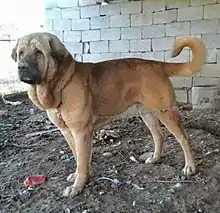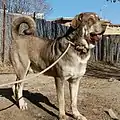Kurdish Mastiff
The Kurdish Mastiff,[1][2][3][4] Assyrian Shepherd,[3] or Pishdar dog[5] (Kurdish: سەگی پشدەری) is a dog landrace native to the mountainous Kurdistan Region in Iraq.[3][5] This dog is often used as a livestock guardian against predators and number around a few thousand heads.[5] They have been compared to the Kangal Dog and the Akbash.[5]
| Kurdish Mastiff | |
|---|---|
 Kurdish mastiff | |
| Common nicknames | Pshdar dog |
| Origin | Iraq |
| Dog (domestic dog) | |
Description
The weight of the adult dogs increases with age and can reach 80 kg.[5] The average is at 73.50 kg reaching from 67 kg in Sangasar to 80 kg in Qira Diza.[5] The average body length is about 75 cm with the back length of aged dogs reaching over 88 cm.[5]
History
In 1892, John Paul Dudley published a medical treatise on dogs and mentioned the Kurdish Mastiff:
In Kurdistan in northern Asia Minor, and that region of Asia, there is a dog much resembling the English Mastiff, which is the constant companion and friend of the Kurd — a shepherd and watch dog partaking much of the character of his half - barbarous master, and will not well bear a change of country and associations. Nothing owned by the Kurd is valued more highly than this fierce and powerful animal, which is to a great extent treated as sacred, at least so far as the hand of a stranger is concerned. In color the Kurdish Mastiff is mainly tawny; has tail long, and head large, and his body is tall, ponderous, and well proportioned".[1]
Image gallery
 Kurdish Mastiff
Kurdish Mastiff Kurdish Mastiff
Kurdish Mastiff
See also
References
- Dudley, John Paul; Irelan, John Robert (1892). Homo Et Canis: Or, The Autobiography of Old Cato and Some Account of His Race. Republic Publishing Company. p. 143.
- "Field Museum of Natural History Bulletin". Field Museum of Natural History: 9. 1987.
- Mohammed, Sarkawt (18 February 2020). "Saqqez dog breeder raises famed Kurdish Mastiffs". Rudaw.
- Burton, Isabel (2009). The Inner Life of Syria, Palestine, and the Holy Land. Columbia University. p. 500.
- "Genetic Evaluation And Factors Affecting Body Weight And Dimensions Of Pishdar Dog In Kurdistan, Iraq". Biochemical and Cellular Archives: 2761. 2020. ISSN 0972-5075.